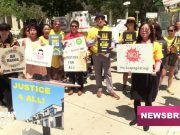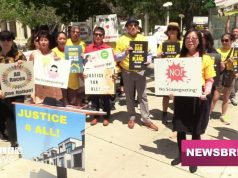It’s 4 a.m. and in a Miami Lakes home, a cell phone alarm alerts Nala Pierre, 26, to the more-than-10-hour day ahead. She rises before most of her neighbors and goes through a normal morning routine, except when it comes to preparing her bag.
She has to double-check her backpack has essentials like deodorant, a power bank in case she can’t find a place to charge her phone, and a towel for the Miami sun. She makes sure she’s got everything because once the door is locked, there’s no turning around.
Pierre, like many living in Miami without a car, must make a longer-than-necessary trek to work. In her case, it’s 19 miles to the Holtz Children’s Hospital in Miami’s Civic Center. The journey sometimes involves more than one form of public transportation as well as transferring buses. All of this takes up so much time that she feels like she spends just as long waiting for the bus as she does riding it.
It takes her about 58 minutes on a good day to reach her final stop before she has to walk for another 5 minutes to get to her job. Often it is longer.
“This is why I bring the things that I bring with me,” she said. “When you’re on the road for so long anything can happen and you can’t always stop somewhere and deal with it.”
Miami-Dade’s bus system is either too slow, too old, or sporadic in its arrival times. It doesn’t always get people exactly where they need to go, but people need it. So the conversation usually stops there. However, one advocacy group has been pushing an idea that it hopes is easier to swallow, using what already exists rather than adding something completely new.
County commissioners are considering an initiative called the Better Bus Project, created by the Transit Alliance, a public transportation advocacy group, that would radically redo dozens of bus routes that thousands of people like Pierre count on every day. It would expand some routes and reduce or even cancel some others in an attempt to make the system more useful. While some riders love the idea, many others are concerned about the effect it will have on their lives. A vote is likely next month.
“The bus system in Miami hasn’t changed for about 30 years,” said Derrick Holmes, the Campaign Coordinator at Transit Alliance. “So you’re talking about a system that hasn’t kept up with the rapid changes to the city layout and its population’s needs.”
The alliance is a non-profit organization that advocates for more frequent and reliable public transportation, as well as safer streets for pedestrians and bikers. It relies mostly on donations, grants, and volunteer work.
The Better Bus Project is the product of a two-year process during which the alliance surveyed and collected data from about 5,000 people across the county. Eventually they created a map of what a “better bus route network” would look like. This map they assembled, Holmes says, would require rewiring the bus system to emphasize the most traveled routes and make the service more efficient. In October 2020, the alliance’s findings — though not the overall plan — was approved by the majority of County Commissioners.
Everybody wasn’t happy, though. Because the county’s $742 million transportation budget isn’t likely to change much, the plan had strict parameters.
Commissioner Barbara Jordan cast the one dissenting vote on the Transit Alliance’s findings. She felt the districts she represents, including Miami Gardens, weren’t going to benefit from this. She said people in her community will have to sacrifice while other areas, particularly on the county’s east side, get a better bus system.
She said that the proposed new network prioritizes ridership over coverage. People who actually need transportation the most are not being taken into account because they reside in low-traffic areas.
“This hurts my community,” said Jordan. “By giving them longer wait times and further bus routes”
Holmes explained that before the Transit Alliance embarked on this campaign, its members understood that every time the county bus system experienced low ridership, the first move was to cut the budget. This, in turn, led to decreases in service and even lower ridership. Then the cycle continued.
So the alliance’s leaders knew that any new project would have to be practical and not scare those in the public who were wary of anything with a high price tag.
“This is a good way to ease the public into being more open to investing more money and resources into public transportation,” said Holmes. “By showing them that we can make changes right now with what we already have.”
The analysis considered whether buses are meandering through the city with random stops rather than making use of the grid layout. It measured service hours in areas with dense ridership to see if they should start earlier and/or run later into the night. It also checked frequency. This information was then processed and turned into a plan for updating the bus system. Holmes feels that this is a more cost-effective alternative than building more highways or expanding roadways.
“Adding more expressways isn’t going to fix things,” said Holmes. “If that were the case, then the traffic issue would have been solved years ago.
The project’s overall aim will be to decrease riders’ wait time to about 15 minutes for most routes. To accomplish this, about 99 routes will be evaluated to see where some stops can either be eliminated or moved to other routes that would line up better. Roughly 30 routes will be discontinued; many of those routes will be serviced by changes in others. The end goal is to make the routes more linear, thereby helping to shave off runtime.
The county commission first voted on the plan last October. The vote to accept Transit Alliance’s findings in the Better Bus project report was 12 to 1 with only commissioner Jordan opposed.
After that the Department of Transportation & Public Works continued work and held hearings to assemble a final proposed network plan for commissioners to vote on. This involved reaching out to the community for feedback and revising the Better Bus Network map several times. This process, along with the pandemic, pushed back the initial date, April, for the vote. The plan is expected to be voted on in September.
Although some riders might be asked to give up their closest bus stop, the potential for a much more efficient and faster bus service is there. People like Pierre, who feel like she spends more than a quarter of her day on the road, might catch a ride more quickly. Indeed the Better Bus plan will connect her more quickly to the Metrorail.
“Anything that cuts down on my commute is a welcome change for me,” she said. “This might not make everyone happy, but you’ve got to start somewhere.”
For part 2 click here,



































